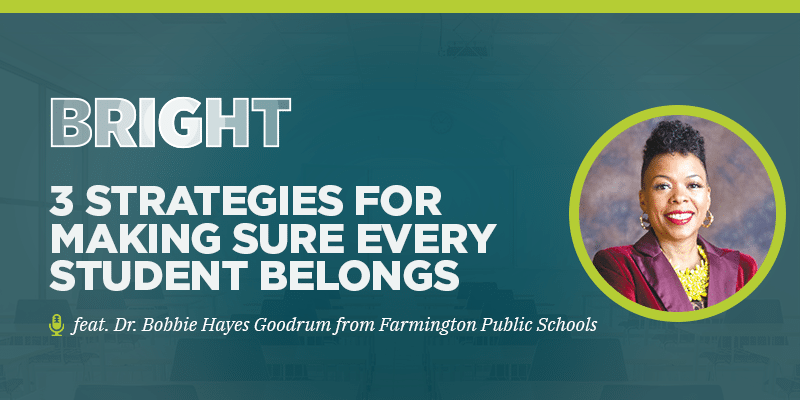Or listen on Apple, Spotify, Google, or another platform. Alternatively, you can read along with the transcript.
There’s a big difference between “tolerance” and “belonging.”
You can feel this distinction on a personal level by answering the question: Would you rather be tolerated in your community or feel like you belong?
In this episode of the BRIGHT podcast, I chat with Dr. Bobbie Hayes Goodrum, assistant superintendent of diversity, equity, and inclusion at Farmington Public Schools. Together, we explore:
- Dr. Hayes Goodrum’s personal definitions of “diversity,” “equity,” “inclusion,” and “justice,”
- Why this work is so essential in education,
- Why the language we use matters, and
- Three strategies for making sure every student belongs.
Here’s a sneak peek at our conversation:
You can listen to my conversation with Dr. Hayes Goodrum using the audio player above or by subscribing to the BRIGHT podcast in your app-of-choice (find us on Apple, Spotify, Google, and more) or by reading along with the transcript.
Of course, we understand that educators are busier than ever. If you don’t have time to listen to Dr. Hayes Goodrum’s full episode (which offers the fuller effect of her wisdom, energy, and examples), you can still benefit from a glimpse at her top three tips for making sure every student belongs below!
3 strategies for making sure every student belongs
- See each and every student as an individual
It’s really important to remember to see each student, each person, as an individual and not just as part of a group. “Don’t see a Black woman in front of you,” says Dr. Hayes Goodrum. “See Bobbie.” Seeing someone means listening to them, paying attention, and giving them the opportunity to tell you who they are before you’ve already decided. We have a tendency to funnel people down to their most visible identity, but this may not be the identity that is the most personal or most affirming in the way that they see themselves.
- Integrate student interests into the curriculum
Regardless of what subject matter you teach, there are ways to integrate student interests into the subject matter. This step makes students more likely to engage with their teacher, their classmates, and subject matter. It helps students feel like they belong because a piece of their life has been integrated into the curriculum.
- Show them that you care (and fake it ‘til you make it)
Perhaps the most important way to make sure students feel like they belong in school is just to care. This can minimally look like saying hello and goodbye to students, learning their names, or asking how their day is going. “I don’t say this lightly because I want you to authentically care,” says Dr. Hayes Goodrum. “But fake it until you make it.” Students often feel isolated, especially if not even the adults in the building are talking to them. It’s cliché but so true that “students don’t care how much you know until they know how much you care.”
My favorite quotes from this episode
“I avoid using the word tolerance. I don’t ever want to be tolerated. If you tolerate me, I don’t feel like you’re welcoming me. I don’t feel like you have open arms toward me. I feel like you’re begrudgingly saying, “You can stay.” No thanks. I’m not looking for that type of relationship, and I don’t think that our children in their relationship with school should feel tolerated. They should feel like, ‘This is where I belong.’”
“When we talk about belonging, we’re talking about breaking down walls. Because when you don’t feel like you belong, you feel like there’s a wall around you, and that wall prevents you both from engaging with other people and engaging in content. There’s plenty of research to support that belonging is a piece of self-esteem. All of these things have been found to be factors that impact how a student performs in school.”
“We always try to funnel people down to their most visible identity, which may not even be the identity that is most personal or most affirming to them in the way that they see themselves.”
Related resources
- Learn and earn: Register for new inclusive teaching and learning professional development courses
- Listen: Valuing vs. acknowledging diversity in education
- Listen: When school feels like home, something wonderful happens







